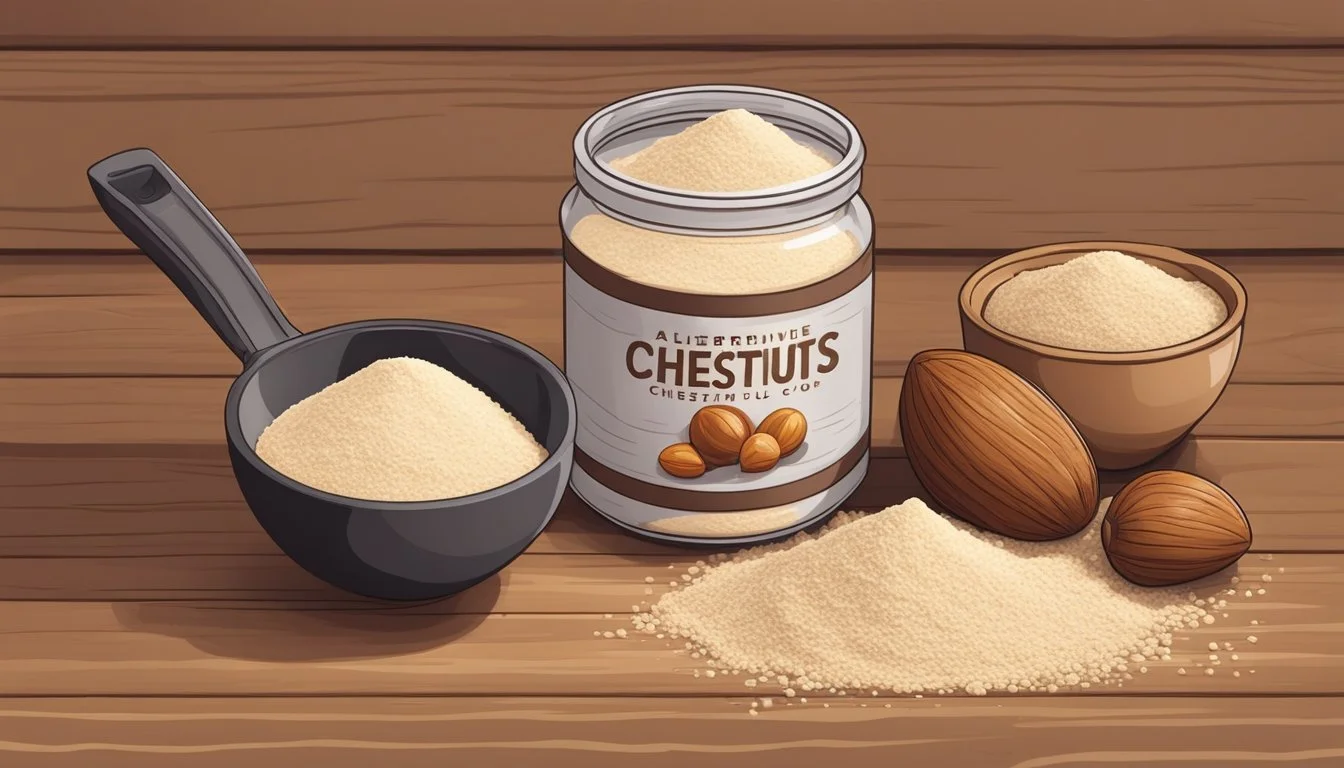Chestnut Flour Substitutes
Top Alternatives for Baking and Cooking
Chestnut flour is a versatile ingredient favored in gluten-free baking for its unique nutty flavor and rich nutritional profile. Whether you're looking to enhance the texture of pastries or create low-carb bread, finding the right substitute can be a game-changer in your recipes. Almond flour stands out as an excellent substitute, closely mimicking the texture and taste of chestnut flour, making it ideal for various baking applications.
For those who desire a low-carb option, coconut flour is another great alternative. It offers a gluten-free solution with a subtle sweetness that complements baked goods. Additionally, rice flour provides a mild and neutral taste, suitable for those seeking an all-purpose substitute that performs well in both sweet and savory dishes.
Consider also peanut flour, which boasts a high protein content that can significantly boost the nutritional value of your recipes. Although it has a distinct peanut flavor, it can be an appropriate substitute for baking and certain savory dishes, provided there are no peanut allergies. Each of these substitutes brings something unique to the table, ensuring your gluten-free baking remains both delicious and nutritious.
Understanding Chestnut Flour
Chestnut flour is a versatile ingredient known for its sweet, nutty flavor and beneficial nutritional profile. This section breaks down its key aspects including nutritional content, culinary uses, and its distinct taste and texture.
Nutritional Profile
Chestnut flour is rich in fiber, vitamins, and essential minerals. It contains potassium, copper, and manganese, which are vital for various bodily functions. Unlike many other flours, chestnut flour has relatively low protein content but compensates with high levels of Vitamin C and antioxidants, contributing to overall health.
Nutritional Breakdown per 100g:
Nutrient Amount Fiber 5-7g Protein 3-4g Potassium 500-700mg Vitamin C 26mg Copper 0.5mg Manganese 1.0mg
These nutrients make chestnut flour a valuable addition to a gluten-free diet.
Culinary Uses
Chestnut flour's sweet, nutty flavor makes it suitable for various baked goods. It is often used in bread, cakes, cookies, pastries, and pancakes. Its unique properties also allow it to be incorporated into homemade pasta and other traditional dishes.
Common Culinary Applications:
Bread: Adds a soft, moist texture with a slightly sweet taste.
Cakes and Cookies: Enhances both flavor and texture.
Pastries: Provides a delicate crumb structure.
Pancakes: Contributes to a light, fluffy interior.
Pasta: Used in certain Italian recipes for a distinctive flavor.
These uses demonstrate chestnut flour's adaptability in various culinary contexts.
Taste and Texture
Chestnut flour is distinguished by its sweet, nutty flavor which adds depth to both savory and sweet recipes. It has a fine texture that helps create a smooth batter, giving baked goods a tender crumb. The flour is slightly more dense and moist compared to other flour types, which can affect the final product's texture.
Sweet Flavor: Complements various sweet and savory dishes.
Nutty Undertones: Adds a rich, robust taste.
Fine Texture: Ensures a smooth mixture and consistent results.
Dense and Moist: Alters the texture, making it ideal for certain recipes.
Overall, chestnut flour offers a unique combination of flavor and texture that can elevate many recipes.
Major Chestnut Flour Substitutes
Chestnut flour substitutes not only offer a range of flavors and textures but also cater to various dietary needs and preferences. Below are some of the key alternatives that can replace chestnut flour in baking and cooking.
Almond Flour
Almond flour is a popular substitute due to its fine texture and slightly sweet, nutty flavor, which closely resembles chestnut flour. Made from finely ground almonds, it is an excellent gluten-free alternative.
Nutritional Benefits:
High in protein: Supports muscle growth and repair.
Healthy fats: Promotes heart health.
Rich in fiber: Aids digestive health.
Usage Tips: Use almond flour in a 1:1 ratio as a substitute for chestnut flour. It is ideal for baking pastries, cakes, and breads. Almond flour can also be used to create gluten-free and low-carb recipes.
Hazelnut Flour
Hazelnut flour, made from ground hazelnuts, offers a rich, nutty flavor that can enhance various baked goods. It serves as a gluten-free alternative with a unique taste profile.
Nutritional Benefits:
Rich in healthy fats: Supports heart health.
Contains protein: Promotes muscle health.
Provides fiber: Improves digestive health.
Usage Tips: Use hazelnut flour to replace chestnut flour in pastries, cookies, and cakes. It works well in a 1:1 ratio but may provide a richer flavor, so adjust to taste. It's particularly suitable for recipes where a pronounced nutty flavor is desired.
Coconut Flour
Coconut flour is derived from dried coconut meat and is known for its fiber content and slightly sweet taste. It is a starchy and gluten-free option that can be distinctively different from chestnut flour.
Nutritional Benefits:
High in fiber: Enhances digestive health.
Low in carbs: Ideal for low-carb diets.
Contains healthy fats: Boosts energy levels.
Usage Tips: Coconut flour absorbs more liquid than chestnut flour. Replace chestnut flour with 1/3 to 1/2 part coconut flour and increase the liquid in the recipe. It works well in cakes, muffins, and other baked goods that can handle more moisture.
Tapioca Flour
Tapioca flour, made from the cassava root, is a starchy, gluten-free flour with a neutral flavor. It is often used as a thickener but can also substitute chestnut flour in some recipes.
Nutritional Benefits:
Gluten-free: Suitable for those with gluten sensitivities.
Source of carbs: Provides energy.
Contains fiber: Supports digestive health.
Usage Tips: Use tapioca flour as a substitute by replacing chestnut flour in a 1:1 ratio for thickening soups, sauces, or stews. In baked goods, it is often combined with other flours for better texture and flavor balance.
Nutritional Considerations When Substituting
When substituting chestnut flour, it's crucial to understand the nutritional differences between chestnut flour and its alternatives. Key areas to consider include protein and fiber content as well as fat and caloric differences.
Protein and Fiber Content
Chestnut flour is known for being lower in protein compared to other nut flours. With chestnut flour, you get around 3 grams of protein per 1/4 cup. High-protein substitutes like peanut flour offer about 15 grams per 1/4 cup, significantly enhancing the protein content of your baked goods.
Fiber also plays a vital role in baking. Chestnut flour provides approximately 2 grams of fiber per 1/4 cup. Almond flour is a good alternative, providing similar fiber levels. Coconut flour, however, is much richer in fiber, packing around 10 grams per 1/4 cup, which can dramatically impact the final product's texture.
Fat and Caloric Differences
Chestnut flour is relatively low in fat, with about 1-2 grams per 1/4 cup. Hazelnut flour and almond flour are rich in healthy fats, offering 14 and 15 grams per 1/4 cup, respectively. This can be beneficial for achieving a moist texture in baked goods, but it will also increase the caloric content.
Caloric content varies among substitutes. Chestnut flour has around 120 calories per 1/4 cup. On the spectrum of substitutes, almond flour contains more calories at approximately 160 calories per 1/4 cup. Coconut flour, while high in fiber, has fewer calories, roughly 100 per 1/4 cup.
Choosing the right substitute depends not only on achieving the desired taste and texture but also on meeting specific nutritional goals for protein, fiber, fat, and calories.
Adapting Recipes with Substitutes
When substituting chestnut flour in recipes, attention to moisture levels and taste adjustments are crucial. Different flours absorb liquids differently and may alter the flavor profile.
Moisture and Liquid Ratios
Due to the varying absorption rates, it's important to adjust moisture when using substitutes. Coconut flour absorbs more liquid than chestnut flour. Therefore, adding extra water or other liquids is necessary to maintain the correct texture. Start with a few tablespoons and adjust gradually.
Hazelnut flour has a more moderate absorption rate. Adding 1-2 teaspoons of additional liquid can balance the consistency. With peanut flour, be cautious as it can quickly become too thick; mild adjustments in liquids should help achieve the desired texture.
For those using lentil puree, note that it contains more moisture. Reduce other liquids in the recipe slightly to avoid an overly wet mixture. Testing and tweaking amounts during mixing ensures optimal results.
Taste and Sweetness Adjustments
Each substitute possesses a unique flavor that can alter the overall taste. For instance, coconut flour brings a light, sweet taste. Consider reducing added sugars when using coconut flour to prevent excessive sweetness.
Hazelnut flour adds a rich, nutty flavor. This pairs well with chocolate in baking recipes but may necessitate minimal adjustments to sugar, especially in savory dishes.
Peanut flour delivers a robust, savory flavor, making it better suited for recipes where its taste complements the dish. Reducing additional sweeteners can balance the intense peanut taste.
When using lentil puree, its mild, earthy flavor works well in various dishes. If sweetness is required, adding natural sweeteners like honey or agave can help maintain the intended flavor profile without overwhelming the original recipe.
Adjustments ensure substitutes enhance, rather than detract from, the final product. Testing small quantities and making incremental changes helps achieve the best results.
Alternative Uses for Chestnut and Other Flours
Chestnut flour and its substitutes offer unique benefits for savory dishes and gluten-free baking. Those looking for flavorful enhancements or satisfying gluten-free options will find various applications.
Savory Dish Enhancements
Chestnut flour can elevate soups, sauces, and gravies with its earthy flavor. It thickens soups effectively without clumping, providing a smooth texture. For sauces, a small amount adds depth and subtle sweetness.
Almond flour, as a substitute, works well in savory applications like breading for chicken or fish, adding a nutty flavor. Hazelnut flour can also be used for a richer taste in savory dishes.
Peanut flour, while high in protein, can alter the flavor profile significantly, making it less suitable for delicate dishes. However, it can be excellent in robust recipes like spicy peanut sauces.
Gluten-Free Baking Innovations
Chestnut flour is prized in gluten-free baking for its fine texture and sweet, nutty taste. It works particularly well in cakes, breads, and cookies, creating moist and flavorful baked goods. Its versatility allows it to blend seamlessly with other gluten-free flours.
Almond flour is another popular gluten-free option. Its finer texture is ideal for light, airy pastries and cakes. Tigernut flour, although not as common, offers a slightly sweet flavor and good binding properties, making it suitable for gluten-free cookies and breads.
These flours, whether chestnut or its substitutes, provide excellent options for creating delicious gluten-free baked goods without compromising on texture or taste.
Storage and Shelf Life of Flours
Proper storage is essential to maintain the freshness and quality of various types of flour. Factors such as using an airtight container and keeping flour in a cool, dry place can significantly affect its shelf life.
Preserving Freshness
Chestnut Flour: To maximize the shelf life of chestnut flour, store it in an airtight container to prevent exposure to moisture and oxygen. This flour should be kept in a cool, dry area, away from direct sunlight. Refrigeration can further extend its shelf life, with potential longevity up to six months.
Almond Flour: Almond flour remains fresh for extended periods when stored properly. Placing it in an airtight container and refrigerating it can keep it usable for up to nine months. For even longer storage, consider freezing it, which can extend its life to about a year.
When dealing with substitutes, such as coconut flour or oat flour, the same storage principles apply. Use airtight containers and keep them in cool, dry places. For longer shelf life, refrigerate or freeze them.
In general, all-purpose flour, when kept in a pantry, lasts about one year. For the best results and extended shelf life, refrigeration is recommended for sensitive varieties like nut flours.






